“Does anybody give a hoot about profit?” - Swiss Deming Institute
“Does anybody give a hoot about profit?” - Swiss Deming Institute
“Does anybody give a hoot about profit?” - Swiss Deming Institute
Create successful ePaper yourself
Turn your PDF publications into a flip-book with our unique Google optimized e-Paper software.
dent of JUSE (the Union of Japanese Scientists<br />
and Engineers), asking me to come<br />
and help Japanese industry. I was able to<br />
go in June 1950, and I was there through<br />
July and August.<br />
It is important to see that top management<br />
invited me: Mr Ishikawa was also President<br />
of the great Kei-dan-ren, the association<br />
of top management. He was highly respected,<br />
unselfish, brilliant. He invited me, and<br />
I took that to mean he was interested. He<br />
was. I knew that I would accomplish nothing<br />
unless he brought top management<br />
together. He did so, at a dinner meeting in<br />
the Industry Club in Tokyo on a Tuesday<br />
night. He brought together the 21 top people<br />
of Japan. My diary has just four sentences<br />
in it, because I did not realize then<br />
how highly important this was to be: I was<br />
just trying to do my job. But I know now<br />
that all I was trying to do depended on that<br />
evening. I had little idea what to say. I tried.<br />
If you read the report written by the<br />
Japanese, I think you will find that the greatest<br />
way I accomplished anything there was<br />
through that diagram, Figure 1 — and the<br />
fact that I had faith in them. I knew that<br />
they could do it. I told them that I thought<br />
I knew what they should do, and that I<br />
could help. I was back in six months, back<br />
in another six months, back the year after<br />
that. Every one of the 21 people in top management<br />
was there every time, at every<br />
conference. They went straight to work. I<br />
told them that, within five years, manufacturers<br />
the world over would be trembling<br />
and would begin to scream for protection.<br />
Several people in top management told me<br />
later that I was the only man in Japan who<br />
believed it. They beat it by a year. I know it:<br />
I was part of it.<br />
Let me tell you what Dean Seebass of the<br />
University of Colorado has said: I did not<br />
export to Japan any American practice. I<br />
took to them something new: it’s still not<br />
known in the Western world. The Japanese<br />
learned it, and went to work. And Figure<br />
1 was the most important force, because<br />
through it they saw manufacturing as a<br />
system, the whole operation as a system.<br />
They already had knowledge, great knowledge,<br />
but it was in bits and pieces. Some<br />
of the bits and pieces were in conflict with<br />
each other. They had knowledge; but they<br />
did not see it as a system.<br />
One need not be eminent in any part of<br />
Profound Knowledge in order to understand<br />
it as a system, and to apply it and to<br />
make it work. One need not be eminent, but<br />
he must understand a system. By “system<strong>”</strong><br />
I mean components that work together for<br />
THE SWISS DEMING INSTITUTE<br />
„Does <strong>anybody</strong> <strong>give</strong> a <strong>hoot</strong> <strong>about</strong> <strong>profit</strong>?“<br />
an aim. And the aim is a value-judgment.<br />
The aim of a system is not a theorem: you<br />
don’t derive it from axioms and corollaries.<br />
The aim that I’d propose for a system is<br />
gain for everybody —stockholders, employees,<br />
suppliers, customers, the community,<br />
the environment. Everybody should<br />
fare better, everybody in the system should<br />
be ahead, his quality of life should improve:<br />
that’s what I mean by the aim of a system.<br />
Remember that without an aim there<br />
is no system. And the aim of a system<br />
must be clear to everybody in it. If we understand<br />
a system, and work on it, then everybody<br />
will gain. Everybody will take part<br />
in the aim, and will be a beneficiary of the<br />
aim. A system is not just composed of divisions,<br />
teams, plants, people: these must<br />
work together to be a system. If we take<br />
Figure 1, but put rings around the various<br />
people and groups (Figure 2), to separate<br />
the people and divide up the company into<br />
components that are competitive, then you<br />
will not have a system: it will destroy itself.<br />
But that’s what we have, that is what we<br />
have.<br />
By the way, if you break up this system<br />
into parts, all competitive and in conflict,<br />
you lengthen the time it takes from inception<br />
of new product to get it into the hands<br />
of the customer — everybody dragging his<br />
feet, interfering with everybody else in that<br />
chain of events, in conflict with all others.<br />
The cost of the delay we cannot measure.<br />
Look out for innovation. The copying machine<br />
is an example. The Halogen-Xerox<br />
people, working 24 hours a day, developed<br />
a copying machine based on the photovoltaic<br />
effect. They engaged a marketing<br />
consultant to look into the possible market<br />
for a copying machine, on the assumption<br />
that they could successfully develop one.<br />
His report was: “It’s an interesting device,<br />
Suppliers of<br />
Materials and<br />
Equipment<br />
A<br />
B<br />
C<br />
D<br />
Receipt and Test of<br />
Materials<br />
Production<br />
Tests of<br />
Processes,<br />
Machines,<br />
Methods, Costs<br />
but of little commercial value.<strong>”</strong><br />
Dr Neave read yesterday a report to Western<br />
Union, a telegraph company of North<br />
America, from 1876. They were thinking<br />
of going into the telephone business. A<br />
consultant advised them that the telephone<br />
had no future. It was an interesting device,<br />
but they should forget it. This telephone<br />
has too many shortcomings to be<br />
seriously considered as a means of communication.<br />
Whereupon they forgot it.<br />
Think what they could have done. The<br />
Halogen-Xerox people continued in spite<br />
of the sad, unattractive market that somebody<br />
predicted for them.<br />
The Japanese learned what a system is, the<br />
whole system, and optimization of a system.<br />
They learned it: it’s not difficult.<br />
They made it work. Again, I did not export<br />
American practice. What I took to Japan<br />
was new knowledge, profound knowledge<br />
— and it came from the outside.<br />
Optimization of a system should be the<br />
basis for negotiation between any two<br />
people. They should form a system. Any<br />
two people should regard themselves as<br />
components of a system; any two divisions,<br />
or three, union, labor, and management,<br />
should regard themselves as parts<br />
of the same system. And the aim is optimization,<br />
in which everybody gains. This<br />
should be the rule for negotiation between<br />
competitors, between countries. Everybody<br />
would gain.<br />
Let me add this: He that goes into negotiation<br />
with the aim to protect his rights is<br />
licked. The aim should be overall gain by<br />
which everybody comes out ahead. He that<br />
goes into it with the idea just to defend his<br />
rights does not understand a system.<br />
Let’s look at the diagram in Figure 3. It has<br />
a scale showing degrees of interdepen-<br />
Design and<br />
Redesign<br />
Assembly Inspection<br />
Figure 2: Production Not Viewed as a System<br />
Consumer<br />
Research<br />
Distribution<br />
Consumers<br />
- 3 - Ernst C. Glauser






